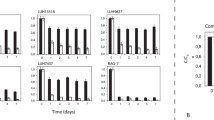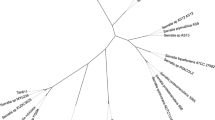Abstract
The peculiar biotechnological applications of Oleispira spp. in the natural cleansing of oil-polluted marine systems stimulated the study of the phenotypic characteristics of the Oleispira antarctica RB-8(T) strain and modifications of these characteristics in relation to different growth conditions. Bacterial abundance, cell size and morphology variations (by image analysis) and hydrocarbon degradation (by gas chromatography with flame ionization detection, GC-FID) were analysed in different cultures of O. antarctica RB-8(T). The effects of six different hydrocarbon mixtures (diesel, engine oil, naval oil waste, bilge water, jet fuel and oil) used as a single carbon source combined with two different growth temperatures (4° and 15 °C) were analysed (for 22 days). The data obtained showed that the mean cell volume decreased with increasing experimental temperature. Three morphological bacterial shapes were identified: spirals, rods and cocci. Morphological transition from spiral to rod and coccoid shapes in relation to the different substrates (oil mixtures) and/or growth temperatures was observed, except for one experimental condition (naval oil waste) in which spiral bacteria were mostly dominant. Phenotypic traits and physiological status of hydrocarbon-degrading bacteria showed important modifications in relation to culture conditions. These findings suggest interesting potential for strain RB-8(T) for ecological and applicative purposes.




Similar content being viewed by others
Data Availability
Material described in the manuscript, including all relevant raw data, will be freely available to any researcher wishing to use them for non-commercial purposes.
References
La Ferla R, Azzaro M, Michaud L et al (2017) Prokaryotic abundance and activity in permafrost of the Northern Victoria Land and Upper Victoria Valley (Antarctica). Microb Ecol 74(2):402–415
Young KD (2006) The selective value of bacterial shape. Microbiol Mol Biol Rev 70:660–703
Young KD (2007) Bacterial morphology: why have different shapes? Curr Opin Microbiol 10:596–600
Straza TR, Cottrell MT, Ducklow HW, Kirchman DL (2009) Geographic and phylogenetic variation in bacterial biovolume as revealed by protein and nucleic acid staining. Appl Environ Microbiol 75:4028–4034
Žmuda M (2004) Abundance and morphotype diversity of surface bacterioplankton along the Gdynia-Brest transect. Oceanol Hydrobiol Stud 34:3–17
Cottrel MT, Kirchman DL (2004) Single-cell analysis of bacterial growth, cell size, and community structure in the Delaware estuary. Aquat Microb Ecol 34:139–149
Posch T, Franzoi J, Prader M, Salcher MM (2009) New image analysis tool to study biomass and morphotypes of three major bacterioplankton groups in an alpine lake. Aquat Microb Ecol 54:113–126
Fasulo S, Guerriero G, Cappello S et al (2015) The “SYSTEMS BIOLOGY” in the study of xenobiotic effects on marine organisms for evaluation of the environmental health status: biotechnological applications for potential recovery strategies. Rev Env Science and Bio/Tech 14:339–345
Kuhn E, Ichimura AS, Peng V et al (2014) Brine assemblages of ultrasmall microbial cells within the ice cover of Lake Vida. Antarctica Appl Environ Microbiol 80(12):3687–3698
Racy F, Godinho MJL, Regali-Seleghim MH, Bossolan NRS, Ferrari AC, Lucca JV (2005) Assessment of the applicability of morphological and size diversity indices to bacterial populations of reservoir in different trophic states. Acta Limnol Brasil 17:395–408
La Ferla R, Maimone G, Lo Giudice A, Azzaro F, Cosenza A, Azzaro M (2015) Cell size and other phenotypic traits of prokaryotic cells in pelagic areas of the Ross Sea (Antarctica). Hydrobiologia 761:181–194
Cefali E, Patanè S, Arena A et al (2002) Morphologic variations in bacteria under stress conditions: near- field optical studies. Scanning 24:274–283
La Ferla R, Lo Giudice A, Maimone G (2004) Morphology and LPS content for the estimation of marine bacterioplankton biomass in the Ionian Sea. Sci Mar 68(1):23–31
Shi B, Xia X (2003) Changes in growth parameters of Pseudomonas pseudoalcaligenes after ten months culturing at increasing temperature. FEMS Microbiol Ecol 45(2):127–134
James JA, Korber DR, Caldwell DE, Costerton JW (1995) Digital image analysis of growth and starvation responses of a surface-colonizing Acinetobacter sp. J Bacteriol 177(4):907–915
Sousa AM, Machado I, Pereira MO (2011) Phenotypic switching: an opportunity to bacteria thrive. In: Méndez-Vilas (ed.) Science against microbial pathogens: communicating current research and technological advances. Formatex Research Center, pp 252–262
La Ferla R, Maimone G, Caruso G et al (2014) Are prokaryotic cell shape and size suitable to ecosystem characterization? Hydrobiologia 726:65–80
Pernthaler J, Amann R (2005) Fate of heterotrophic microbes in pelagic habitats: focus on populations. Microbiol Mol Biol Rev 69:440–461
Thingstad TF, Øvreås L, Egge JK, Løvdal T, Heldal M (2005) Use of non-limiting substrates to increase size; a generic strategy to simultaneously optimize uptake and minimize predation in pelagic asmotrophs? Ecol Lett 8:675–682
Shimizu K (2014) Regulation systems of bacteria such as Escherichia coli in response to nutrient limitation and environmental stresses. Metabolites 4(1):1–35
Sinha R, Karan R, Sinha A, Khare SK (2011) Interaction and nanotoxic effect of ZnO and Ag nanoparticles on mesophilic and halophilic bacterial cells. Bioresource Technol 102:1516–1520
Xie T, He Y, Irwin PL, Jin T, Shi X (2011) Antibacterial activity and mechanism of action of zinc oxide nanoparticles against Campylobacter jejuni. Appl Environ Microb 77(2325):2331
Tuson HH, Weibel DB (2013) Bacteria–surface interactions. Soft Matter 9:43–68
Cappello S, Guglielmino G (2006) Effects of growth temperature on the adhesion of Pseudomonas aeruginosa ATCC 27853 to polystyrene. Ann Microbiol 56(4):383–385
Costa K, Bacher G, Allmaier G et al (1999) The morphological transition of Helicobacter pylori cells from spiral to coccoid is preceded by a substantial modification of the cell wall. J Bacteriol 181(12):3710–3715
Holmquist L, Kjelleberg S (1993) Changes in viability, respiratory activity and morphology of the marine Vibrio sp. Strain S14 during starvation of individual nutrients and subsequent recovery. FEMS Microbiol Ecol 12:215–224
Løvdal T, Skjoldal E, Heldal M, Norland S, Thingstad T (2007) Changes in morphology and elemental composition of Vibrio splendidus along a gradient from carbon-limited to phosphate-limited growth. Microb Ecol 55:152–161
Yakimov MM, Timmis KN, Golyshin PN (2007) Obligate oil-degrading marine bacteria. Curr Opin Biotechnol 18:257–266
Gentile G, Bonsignore M, Santisi S et al (2016) Biodegradation potentiality of psycrhrophilic bacterial strain Oleispira antarctica RB-8T. Mar Pollut 105:125–130
Yakimov MM, Giuliano L, Gentile G et al (2003) Oleispira antarctica gen. nov., sp. nov., a novel hydrocarbonoclastic marine bacterium isolated from Antarctic coastal seawater. Int J Syst Evol Microbiol 53:779–785
Bissett A, Bowman J, Burke C (2006) Bacterial diversity in organically-enriched fish farm sediments. FEMS Microbiol Ecol 55:48–56
Gerdes B, Brinkmeyer R, Dieckmann G, Helmke E (2005) Influence of crude oil on changes of bacterial communities in Arctic sea-ice. FEMS Microbiol Ecol 53:129–139
Prabagaran SR, Manorama R, Delille D, Shivaji S (2007) Predominance of Roseobacter, Sulfitobacter, Glaciecola and Psychrobacter in seawater collected off Ushuaia, Argentina, sub-Antarctica. FEMS Microbiol Ecol 59:342–355
Dyksterhouse SE, Gray JP, Herwig RP, Lara JC, Staley JT (1995) Cycloclasticus pugetii gen. nov., sp. nov., an aromatic hydrocarbon-degrading bacterium from marine sediments. Int J Syst Bacteriol 45:116–123
Porter KG, Feig YS (1980) The use of DAPI for identifying and counting aquatic microflora. Limnol Oceanogr 25:943–948
Lee S, Fuhrman A (1987) Relationship between biovolume and biomass of naturally derived bacterioplankton. Appl Environ Microbiol 53:1298–1303
Krambeck C, Krambeck HJ, Overbeck J (1981) Microcomputer assisted biomass determination of plankton bacteria on scanning electron micrographs. Appl Environ Microbiol 42:142–149
Massana R, Gasol JP, Bjørnsen PK et al (1997) Measurement of bacterial size via image analysis of epifluorescence preparations: description of an inexpensive system and solutions to some of the most common problems. Sci Mar 61:397–407
Della Torre C, Tornambè A, Cappello S et al (2012) Modulation of CYP1A and genotoxic effects in European seabass Dicentrarchus labrax exposed to weathered oil: a mesocosm study. Mar Environ Res 76:48–55
Crisafi F, Denaro R, Genovese M, Cappello S, Mancuso M, Genovese L (2011) Comparison of 16SrDNA and toxR genes as targets for detection of Vibrio anguillarum in Dicentrarchus labrax kidney and liver. Microbiol Res 162(3):223–230
Yakimov MM, Cappello S, Crisafi E et al (2006) Phylogenetic survey of metabolically active microbial communities associated with the deep-sea coral Lophelia pertusa from the Apulian plateau, Central Mediterranean Sea. Deep-Sea Res I 53:62–75
Ng LK, Sherburne R, Taylor DE, Stiles ME (1985) Morphological forms and viability of Campylobacter species studied by electron microscopy. J Bacteriol 164:338–343
Acknowledgements
The authors are grateful the project P.O.FSE—SICILIA 2014–2020 “SANi – Salute e Ambiente – Fattori di rischio da contaminanti nei disordini del Neurosviluppo”.
Funding
This work was supported by grants of the National Research Council (CNR) of Italy, by (i) PNRA2013 B4.01 “STRANgE” and (ii) PNRA2015_00090 Plastic in Antarctic Environment (PLANET Project); (iii) PNRA2016 NANOparticelle Polimeriche nell'ambiente marino e negli organismi Antartici (nanoPANTA).
Author information
Authors and Affiliations
Contributions
G.G. and S.C. designed the research. G.G., G.M., M.A., M.C., M.G., S.S., M.M. and A.M. performed lab experiments and data analyses. G.G., G.M. and S.C. wrote the first draft of the manuscript. R.L. revised and improved the manuscript. All authors read and approved the final version of the manuscript.
Corresponding author
Ethics declarations
Conflict of interest
The authors declare no conflicts of interest.
Ethical statement
No human participants and animals have been involved in the research.
Additional information
Publisher's Note
Springer Nature remains neutral with regard to jurisdictional claims in published maps and institutional affiliations.
Rights and permissions
About this article
Cite this article
Gentile, G., Maimone, G., La Ferla, R. et al. Phenotypic Variations of Oleispira antarctica RB-8(T) in Different Growth Conditions. Curr Microbiol 77, 3414–3421 (2020). https://doi.org/10.1007/s00284-020-02143-8
Received:
Accepted:
Published:
Issue Date:
DOI: https://doi.org/10.1007/s00284-020-02143-8




